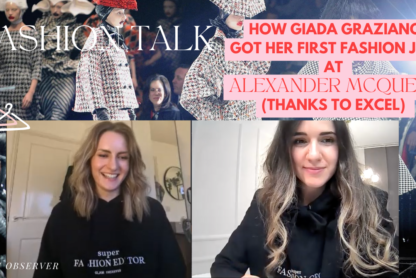In fashion, where trends shift quickly and the competition is fierce and growing, staying relevant and competitive is one of the main challenges for brands nowadays. Therefore, observing the competitors and what they are doing from their product design to marketing strategies is a must to stay ahead of the game.
A competitor analysis is a valuable tool in fashion marketing, allowing companies to not only keep pace with their competitors but also be a few steps ahead by innovating, improving, and positioning their brand for long-term success.
If you are considering a career in fashion marketing, brand management, buying, merchandising, or fashion PR one of your main tasks will consist in conducting a competitor analysis. On Glam Observer, we don’t only share career advice but also give you tools to develop your skills so you can feel more prepared for the role and impress recruiters in your application, job interview, and your first weeks at your new job.
Doing a competitor analysis is also a good project idea for your portfolio if you want to go into marketing or buying. Indeed, I always recommend sending one to recruiters whenever you apply for a fashion internship or job to showcase your skills and boost your chances of getting noticed. (I talk more about the benefits of having a fashion portfolio in this article).
For these reasons, and since fashion marketing is one of the most popular careers in fashion, I thought it would be interesting to share with you what a competitor analysis is, why it is important, and how to do it.
What is a competitor analysis?
A competitor analysis is exactly how it sounds – an analysis of competitors. I will explain below how to identify competitors in fashion, but overall, it’s a tool used by companies to assess competitors to understand their strengths, weaknesses, and strategies, on one hand, and identify competitive advantages, market opportunities, and areas for improvement for you own brand (where you work or aspire to work.) on the other hand.
Why is a competitor analysis important in fashion?
Understand Market Position: A competitor analysis helps you understand where your brand stands in the market relative to other brands and assess its business performance. This will be particularly relevant if you are launching a new fashion brand to decide in which category to position it, or when you are studying where the company you work at (or aspire to work) stands in the market.
Identify gaps in the market and opportunities: Obviously, not everything that competitors present on the market results effectively, hence a competitor analysis can help not only to see what’s working best but also identify where there is room for improvement. You can also find out that the niche market is empty, for example, if no major competitor is offering vegan leather products, this could be a gap your brand could fill.
Stay ahead of the industry trends: Competitor analysis often reveals new trends (like sustainability, technological advancements in fashion, etc.) that brands can capitalize on before they become mainstream.
Improve the brand’s product offering: You can assess the fashion company’s offer and see if there is room for expanding, improving, or even discontinuing any product category or line. During a competitor analysis in fashion, you can also benchmark the brand’s performance and improve areas such as pricing, quality, packaging, and customer experience.
Enhance Marketing and Communication Strategies: Insights from competitors can help brands understand the current trends in campaigns and social media content can bring ideas on how to attract more attention from customers.
Risk Mitigation: A competitor analysis also helps mitigate risks, such as new entrants in the market and shifts in consumer preferences, and make informed strategic decisions to grow the brand
Ultimately, the goal of the competitive analysis is to gain a competitive advantage over other brands by analyzing the aforementioned elements.
How to do a competitor analysis in fashion?
Identify the competitors
Start by identifying the key competitors in the fashion market segment you are focusing on.
You need to consider:
- Direct competitors (brands offering similar products or targeting the same audience). For example, for a luxury fashion company, direct competitors would be other luxury brands. For instance, some of Chanel’s competitors include Dior, Hermes, Louis Vuitton, Saint Laurent, and Prada.
- Indirect competitors aka brands that target a similar audience but do not compete in terms of product categories. For example, in the luxury industry, a Dior customer might decide to invest in a high jewelry product, a car, or stay at a luxury hotel instead of giving priority to a bag.
To make things easier when you start doing a competitor analysis, it’s okay to consider direct competitors only.
Elements to Include in a Fashion Competitor Analysis
Before you start, make sure you know the ins and outs of your fashion brand (where you work or aspire to work). Then, look into the following areas for each competitor:
- Positioning: Assess how the company positions itself in terms of price, value, and perceived exclusivity. These are some of the questions to take into account when doing your competitor analysis: Is the brand positioned as a luxury, mid-range, or budget brand? How do their prices compare across different product lines? What does the brand stand for (timeless designs, casual looks, etc.)
You can create a graphic like the one below to demonstrate the positioning of the brands:

- Product Mix: Analyze the product assortment of each competitor by looking into the product categories they are selling: womenswear, shoes, bags, etc. In addition to the types of products, you can compare their styles, quality, sustainability, etc. For example are they a minimalistic brand? Do they focus on particular fabrics? One of the key elements you should analyze when you run a competitor analysis in fashion and you look at the product offers of other brands is their best-sellers.
- Target Audience:
Analyzing who the brand is aiming to sell and communicate to is a big part of competitor analysis because understanding the customer is key for any company. No strategy is successful without listening to the customer. So when doing your fashion competitor analysis you need to look also at the target audience of each brand you are studying. What is their target audience’s age, gender, income level, and location? What are the lifestyles, interests, and values? (e.g., young professionals, eco-conscious consumers…) Imagine you name the customer X and you analyze her/his daily life from morning to night. What do they do, who are they, and where do they live? Are they students?
- Distribution Channels: Explore the distribution channels used by each competitor. Look at their physical stores and e-commerce platforms, whether they are stocked in department stores, (Saks, Harrods, La Rinascente…) online retailers (Net-a-Porter, MyTheresa, Luisaviaroma…), or both. In addition, look at the regions where they are operating.
- Marketing and Communication Strategies: Evaluate the marketing and communication strategies of each competitor. Look at their advertising campaigns, social media presence, influencer collaborations, public relations efforts, and content marketing initiatives.
- Visual Branding & Design: Fashion is a highly visual industry, so it’s crucial to examine how competitors present their brands. Analyze the visual elements used across their marketing and advertising materials and try to understand what they say about a brand’s identity. In addition, look into the brand’s messaging – how it uses storytelling to communicate with the audience.
- Customer Service: Since the fashion e-commerce realm is growing, seeing how competitors handle their customer service online is crucial to do a thorough competitor analysis. You can evaluate the user-friendliness of the shopping page, return/exchange policies, the responsiveness of the customer service team, etc.
You can also analyze the customer service in the physical shops. Though it requires more time, you can understand more about how a brand greets, interacts, and provides special attention to its customers.
- Customer Sentiment: Social media platforms can provide useful insight into how customers feel about the brand. For example, Jacquemus relies on building friendly connections with its audience on Instagram. His highly personal marketing strategy makes people feel more in touch and emotional about the brand.
- Beyond Fashion: Gone are the days when fashion companies only make clothes. Nowadays, they are expanding into new markets like beauty, home, and even entertainment and hospitality to diversify their business. Brands that implement this strategy are highly competitive, so it’s an important element to consider when building a competitor analysis.
- In-Store Experience: Many of us go shopping once in a while, so why not make it a field trip for the purpose of your competitor analysis? When you enter a physical store, you should observe everything with an analytical eye – the design, window displays, how products are presented and packaged, the customer service, etc.
Once you reported your findings, it can be useful to summarize them in a brief overview of the product mix.
To return to our example of Chanel, we can say:
- All four brands have a strong presence in the Ready-to-Wear segment.
- Chanel, Saint Laurent, and Prada have broad makeup and skincare offerings, while Louis Vuitton primarily focuses on perfumes.
- Chanel doesn’t offer menswear compared to its competitors.
Finally, as I said in the beginning, make sure you gather all this data about your fashion brand.
Where to find information about fashion brands?
To do the competitor analysis on fashion brands, you can use various sources to research and gather information:
- The fashion companies’ websites
- Social media profiles
- Press releases
- News articles
- Industry reports
- You can also visit their stores and read customer reviews online for more advanced research.
Add a conclusion:
We are approaching the final step. I always recommend finalizing your competitor analysis report with a conclusion to summarize your findings and add final thoughts and remarks. Even though you listed the information priorly and it may be clear, the questions can remain: How can this analysis be traced back to your source brand? Make sure your comparison is clear.
How to present your fashion competitor analysis
Your competitor analysis should be presented in a short, 5-10 pages PDF that you can build on Canva.
I suggest selecting 4 competitors for your research, which should be more than enough to create a comprehensive competitor analysis.
Your report should include information about your source brand, the product mix of your brand and the competitors, and a conclusion, which I explained in detail in this article.
It’s important that your presentation is well structured and visually appealing (logos, colors…) as these details can tell a lot to a recruiter about who you are as a professional.
Finally, I suggest downloading it as a PDF to preserve the layout.
This is it! Building a competitor analysis involves some research and critical analysis, but it’s quite easy to do once you have all the information gathered and follow the structure I recommend.
Want to learn more tips and tricks about how to build an impressive portfolio for fashion companies even without experience? Enroll in my online course Break into the Fashion Industry or start with my free webinar.








